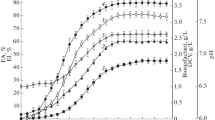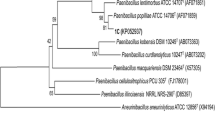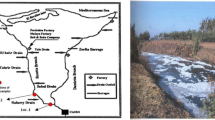Abstract
Six biosurfactant-producing bacteria were isolated from hydrocarbon contaminated soils in Sfax, Tunisia. Isolates were screened for biosurfactant production by different conventional methods including hemolytic activity, surface tension reduction, drop-collapsing and oil displacement tests. All these screening tests show that all the isolates behave differently. Among the isolated bacteria, DCS1 strain was selected for further studies based on its highest activities and it was identified as Bacillus methylotrophicus DCS1. This strain was found to be a potent producer of biosurfactant when cultivated in mineral-salts medium supplemented with diesel oil (2 %, v/v) as a sole carbon source. Physicochemical properties and stability of biosurfactants synthesized by B. methylotrophicus DCS1 were investigated. The produced biosurfactants DCS1, from Landy medium, possess high surface activity that could lower the surface tension of water to a value of 31 from 72 mN m−1 and have a critical micelle concentration (CMC) of 100 mg L−1. Compared with SDS and Tween 80, biosurfactants showed excellent emulsification activities against different hydrocarbon substrates and high solubilization efficiency towards diesel oil. Biosurfactants DCS1 showed good stability in a wide range of temperature, pH and salinity. These results suggested that biosurfactants produced by B. methylotrophicus DCS1 could be an alternative to chemically synthesized surfactants for use in bioremediation processes to enhance the solubility of hydrophobic compounds.








Similar content being viewed by others
References
Abouseoud M, Maachi R, Amrane A, Boudergua S, Nabi A (2008a) Evaluation of different carbon and nitrogen sources in production of biosurfactant by Pseudomonas fluorescens. Desalination 223:143–151
Abouseoud M, Yataghene A, Amrane A, Maachi R (2008b) Biosurfactant production by free and alginate entrapped cells of Pseudomonas fluorescens. J Ind Microbiol Biotechnol 35:1303–1308
Abouseoud M, Yataghene A, Amrane A, Maachi R (2010) Effect of pH and salinity on the emulsifying capacity and naphthalene solubility of a biosurfactant produced by Pseudomonas fluorescens. J Hazard Mater 180:131–136
Arima K, Kakinuma A, Tamura G (1968) Surfactin, a crystalline peptidelipid surfactant produced by Bacillus subtilis: isolation, characterization and its inhibition of fibrin clot formation. Biochem Biophys Res Commun 31:488–494
Banat IM, Franzetti A, Gandolfi I, Bestetti G, Martinotti MG, Fracchia L, Smyth TJ, Marchant R (2010) Microbial biosurfactants production, applications and future potential. Appl Microbiol Biotechnol 87:427–444
Barkay T, Navon-Venezia S, Ron EZ, Rosenberg E (1999) Enhancement of solubilization and biodegradation of polyaromatic hydrocarbons by the bioemulsifier alasan. Appl Environ Microbiol 65:2697–2702
Ben Ayed H, Jridi M, Maalej H, Nasri M, Hmidet N (2014) Characterization and stability of biosurfactant produced by Bacillus mojavensis A21 and its application in enhancing solubility of hydrocarbon. J Chem Technol Biotechnol 89:1007–1014
Ben Ayed H, Jemil N, Maalej H, Bayoudh A, Hmidet N, Nasri M (2015) Enhancement of solubilization and biodegradation of diesel oil by biosurfactant from Bacillus amyloliquefaciens An6. Int Biodeterior Biodegradation 99:8–14
Bodour AA, Gerrero-Barajas C, Jiorle BV, Malcomson ME, Paull AK, Somogyi A, Trinh LN, Bates RB, Maier RM (2004) Structure and characterization of flavolipids, a novel class of biosurfactants produced by Flavobacterium sp. strain MTN11. Appl Environ Microbiol 70:114–120
Carrillo PG, Mardaraz C, Pitta-Alvarez SI, Giulietti AM (1996) Isolation and selection of biosurfactant production bacteria. World J Microbiol Biotechnol 12:82–84
Chandankere R, Yao J, Cai M, Masakorala K, Jain AK, Choi MMF (2014) Properties and characterization of biosurfactant in crude oil biodegradation by bacterium Bacillus methylotrophicus USTBa. Fuel 122:140–148
Chandran P, Das N (2010) Biosurfactant production and diesel oil degradation by yeast species Trichosporon asahii isolated from petroleum hydrocarbon contaminated soil. Int J Eng Sci Technol 2:6942–6953
Darvishi P, Ayatollahi S, Mowlaa D, Niazi A (2011) Biosurfactant production under extreme environmental conditions by an efficient microbial consortium, ERCPPI-2. Colloids Surf B Biointerfaces 84:292–300
Desai JD, Banat IM (1997) Microbial production of surfactants and their commercial potential. Microbiol Mol Biol Rev 61:47–64
Felnagle EA, Jackson EE, Chan YA, Podevels AM, Berti AD, McMahon MD, Thomas MG (2008) Non ribosomal peptide synthetases involved in the production of medically relevant natural products. Mol Pharm 5:191–211
Holt JG, Krieg NR, Sneath PHA, Staley JT, Williams ST (1994) Bergey’s manual of determinative bacteriology, 9th edn. Lippincott, William & Wilkins, Baltimore, Md
Huszcza E, Burczyk B (2003) Biosurfactant production by Bacillus coagulans. J Surfactants Deterg 6:61–64
Landy M, Warren GH, Rosenman SB, Colio LG (1948) Bacillomycin: an antibiotic from Bacillus subtilis active against pathogenic fungi. Proc Soc Exp Biol Med 67:539–541
Macdonald CR, Cooper DG, Zajic JE (1981) Surface-active lipids from Nocardia erythropolis grown on hydrocarbons. Appl Environ Microbiol 41:117–123
Menezes CTB, Barros EC, Rufino RD, Lun JM, Sarubbo LA (2011) Replacing synthetic with microbial surfactants as collectors in the treatment of aqueous effluent produced by acid mine drainage, using the dissolved air flotation technique. Appl Biochem Biotechnol 163:540–546
Milić JS, Beškoski VP, Ilić MV, Ali SAM, Gojgić-Cvijović GD, Vrvić MM (2009) Bioremediation of soil heavily contaminated with crude oil and its products: composition of the microbial consortium. J Serb Chem Soc 74:455–460
Mnif I, Ellouze-Chaabouni S, Ghribi D (2012) Economic production of Bacillus subtilis SPB1 biosurfactant using local agro-industrial wastes and its application in enhancing solubility of diesel. J Chem Technol Biotechnol 88:779–787
Muthusamy K, Gopalakrishnan S, Ravi TK, Sivachidambaram P (2008) Biosurfactants: properties, commercial production and application. Curr Sci 94:736–747
Noudeh GD, Housaindokht M, Bazzaz BSF (2005) Isolation, characterization and investigation of surface and hemolytic activities of a lipopeptide biosurfactant produced by Bacillus subtilis ATCC 6633. J Microbiol 43:272–276
Obayori OS, Ilori MO, Adebusoye SA, Oyetibo GO, Omotayo AE, Amund OO (2009) Degradation of hydrocarbons and biosurfactant production by Pseudomonas sp strain LP1. World J Microbiol Biotechnol 25:1615–1623
Okoh A, Ajisebutu S, Babalola G, Trejo-Hernandez MR (2001) Potential of Burkholderia cepacia RQ1 in the biodegradation of heavy crude oil. Int Microbiol 4:83–87
Perfumo A, Rancich I, Banat IM (2010a) Possibilities and challenges for biosurfactants use in petroleum industry. In: Sen R (ed) Biosurfactants, vol 672. pp 135–157
Perfumo A, Smyth TJP, Marchant R, Banat IM (2010b) Production and roles of biosurfactants and bioemulsifiers in accessing hydrophobic substrates. In: Timmis KN (ed) Handbook of hydrocarbon and lipid microbiology. Springer, Berlin, Germany, pp 1501–1512
Rodrigues LR, Teixeira JA, Van der Mei HC, Oliveira R (2006) Physiochemical and functional characterization of a biosurfactant produced by Lactococcus lactis 53. Colloids Surf B Biointerfaces 49:79–86
Ruggeri C, Franzetti A, Bestetti G, Caredda P, La Colla P, Pintus M, Sergi S, Tamburini E (2009) Isolation and characterization of surface active compound-producing bacteria from hydrocarbon-contaminated environments. Int Biodeterior Biodegradation 63:936–942
Sarubbo LA, Farias CB, Campos-Takaki GM (2007) Co-utilization of canola oil and glucose on the production of a biosurfactant by Candida lipolytica. Curr Microbiol 54:68–73
Sriram MI, Kalishwaralal K, Deepak V, Gracerosepat R, Srisakthi K, Gurunathan S (2011) Biofilm inhibition and antimicrobial action of lipopeptide biosurfactant produced by heavy metal tolerant strain Bacillus cereus NK1. Colloids Surf B Biointerfaces 85:174–181
Sun N, Wang H, Chen Y, Lu S, Xiong Y (2008) Effect of surfactant SDS, Tween 80, Triton X-100 and rhamnolipid on biodegradation of hydrophobic organic pollutants. In: The 2nd international conference, ICBBE2008, bioinformatics and biomedical engineering, pp 4730–4734
Thavasi R, Jayalakshmi S, Banat IM (2011) Application of biosurfactant produced from peanut oil cake by Lactobacillus delbrueckii in biodegradation of crude oil. Bioresour Technol 102:3366–3372
Torres LG, Climent M, Saquelares J, Bandala ER, Urquiza G, Iturbe R (2007) Characterization and treatability of a contaminated soil from an oil exploration zone. Int J Environ Sci Technol 4:311–322
Urum K, Grigson S, Pekdemir T, McMenamy S (2006) A comparison of the efficiency of different surfactants for removal of crude oil from contaminated soils. Chemosphere 62:1403–1410
Wang Q, Fang X, Bai B, Liang X, Shuler PJ, Goddard WA III, Tang Y (2007) Engineering bacteria for production of rhamnolipid as an agent for enhanced oil recovery. Biotechnol Bioeng 98:842–853
Youssef NH, Duncan KE, Nagle DP, Savage KN, Knapp RM, McInerney MJ (2004) Comparison of methods to detect biosurfactant production by diverse microorganisms. J Microbiol Methods 56:339–347
Zhang Z, Schwartz S, Wagner L, Miller W (2000) A greedy algorithm for aligning DNA sequences. J Comp Biol 7:203–214
Zheng C, Wang M, Wang Y, Huang Z (2012) Optimization of biosurfactant-mediated oil extraction from oil sludge. Bioresour Technol 110:338–342
Acknowledgment
This work was funded by the Ministry of Higher Education and Scientific Research, Tunisia.
Author information
Authors and Affiliations
Corresponding author
Rights and permissions
About this article
Cite this article
Jemil, N., Ben Ayed, H., Hmidet, N. et al. Characterization and properties of biosurfactants produced by a newly isolated strain Bacillus methylotrophicus DCS1 and their applications in enhancing solubility of hydrocarbon. World J Microbiol Biotechnol 32, 175 (2016). https://doi.org/10.1007/s11274-016-2132-2
Received:
Accepted:
Published:
DOI: https://doi.org/10.1007/s11274-016-2132-2




